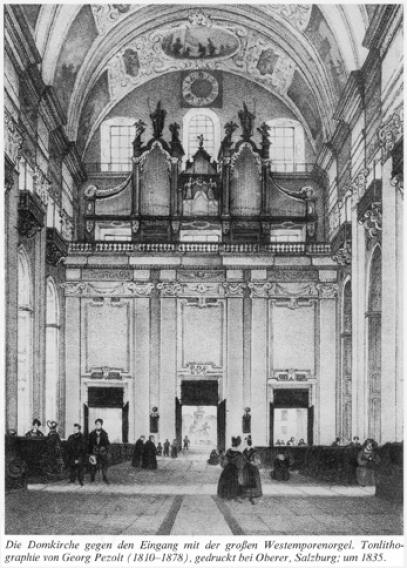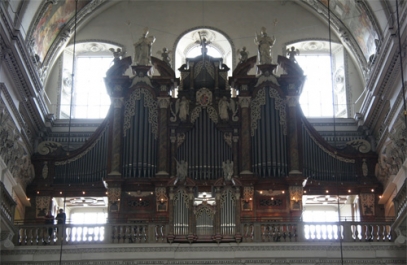


Salzburg, cathedral
Christoph Egedacher 1702-03, enlarged by Johann Christoph Egedacher 1705 and 1718.
State of preservation: After several radical changes in the 19th century and war damage in 1944 only the case is preserved.
The great organ of Salzburg cathedral was of central importance for organ history in the southern German regions and beyond. Salzburg cathedral not only had this great organ on the western gallery but four more organ galleries on the transept corners contributing to the performances of polychoral compositions of the 17th century. The western organ of 1703 and further enlarged shortly after is one of the first and most important examples of an amalgamation of the organ styles north and south of the Alps.

The most important organ of the Egedacher family was built by several generations. Contemporary authors like its organist Johann Baptist Samber (in his "Manuductio ad organum") praised the manifold choices available and the variations of colours, but the early enlargements testify the problem that the organ was not loud enough for the cathedral from its position in the western gallery. This criticism initiated further repairs and a romanticisation during the 19th century leaving nothing og the Egedachers' organ but the case, this as well an example for many important organs of the Baroque.
The Egedacher specification appears as enigmatic as fascinating today. The possible effects of the "big Agges" as a fundament, the contributions of the „Rauschwerk“ with their multitude of ranks of quite different pipe scales to the „völligen Anschlag,“ an obviously quite individual idea of Grand Jeu, or the sounds of the many reed stops especially in the Oberwerk without any comparative examples before and after is completely mysterious, since this organ has never been copied elsewhere, as many other remarkable organs have. So the construction of the Rauschwerke, the stops „Harpa“ and „Scarpa“, or the double (!) reed stop „Sordun“ remains unknown.
Specification
II+P (1703), III+P (1705); manuals C-c3 (short octaves), pedal C-g#0
HW:
Praestant 8’ (tin)
Holzprincipal 8’
Copl 8’ (metal; 1718 into UW)
Quintidena 8’ (metal)
Octav 4’ (metal)
Nacht-Horn 4’ (metal; 1718 UW)
Fleten 4’ (metal)
Quinte 3’ (metal)
Superoctave 2’ 8f. (metal)
Horn oder Sesquialtra 1 3/5’ 4f. (metal)
Mixtur 3’ 6f. (metal)
Cymbl 1’ 4f. (metal)
OW (after 1705: UW):
Viola 8’ (metal; 1718 into HW)
Salicinal 8’ (tin; 1718 HW)
Octav 4’ (tin)
Rohr-Fleten 4’ (metal; 1718 HW)
Quint 3’ (metal)
Wald-Fleten 2’ (tin)
Mixtur 1 1/3’ 3f. (+, 1718)
Harpa 16’ (+1705; after 1718: 8’)
Rauschwerk 13f. (+1705; 1718 HW; „von Metall / und Zungenwerck, ist zum völligen Anschlagen tauglich“)
OW (+1705)
Principal 8’ (tin)
Flett duss 4’ (wood)
Piffaro 4’
Flauten 4’
Flageolett 2’ (tin)
Swegl 2’
Fagott 8’
Trombon 8’
Posaun 8’
Scarpa 4’
Schalmay 4’
Cornetti 2’
P:
Infrabaß (“Der große Agges”) 32’ (wood)
Subbaß 16’ (wood, +1705)
Bourdon 16' (tin; front)
Principal 8’ (tin)
Suboctav 8’ (wood)
Octav 4’ (metal)
Mixtur 3’ 8f. (metal)
Rauschwerk 10f. (metal, +1705)
Bombardon 16’ (+1705)
Sordun 8’ 2f. (+1705)
Voglgsang; Heer-Paucken
Q: Metropolitankapitel (Hrsg.), Festschrift zur Weihe der neuen Großen Orgel, Salzburg 1988.
© Greifenberger Institut für Musikinstrumentenkunde | info@greifenberger-institut.de




